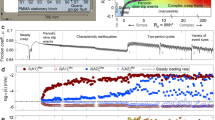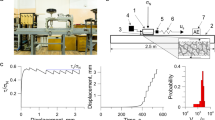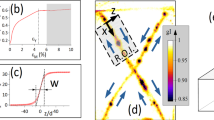Abstract
The 1992 magnitude 7.3 Landers earthquake triggered an exceptional number of additional earthquakes within California and as far north as Yellowstone and Montana1,2,3. Since this observation, other large earthquakes have been shown to induce dynamic triggering at remote distances—for example, after the 1999 magnitude 7.1 Hector Mine1 and the 2002 magnitude 7.9 Denali4 earthquakes—and in the near-field as aftershocks5. The physical origin of dynamic triggering, however, remains one of the least understood aspects of earthquake nucleation1,2,3,4,5. The dynamic strain amplitudes from a large earthquake are exceedingly small once the waves have propagated more than several fault radii. For example, a strain wave amplitude of 10-6 and wavelength 1 m corresponds to a displacement amplitude of about 10-7 m. Here we show that the dynamic, elastic-nonlinear behaviour of fault gouge perturbed by a seismic wave may trigger earthquakes, even with such small strains. We base our hypothesis on recent laboratory dynamic experiments conducted in granular media, a fault gouge surrogate6,7. From these we infer that, if the fault is weak8,9,10, seismic waves cause the fault core modulus to decrease abruptly and weaken further. If the fault is already near failure, this process could therefore induce fault slip.
This is a preview of subscription content, access via your institution
Access options
Subscribe to this journal
Receive 51 print issues and online access
$199.00 per year
only $3.90 per issue
Buy this article
- Purchase on Springer Link
- Instant access to full article PDF
Prices may be subject to local taxes which are calculated during checkout




Similar content being viewed by others
References
Gomberg, J., Reasenberg, P. A., Bodin, P. & Harris, R. A. Earthquake triggering by seismic waves following the Landers and Hector Mine earthquakes. Nature 411, 462–466 (2001)
Scholz, C. H. The Mechanics of Earthquakes and Faulting 2nd edn (Cambridge Univ. Press, Cambridge, 2002)
Hill, D. P. et al. Seismicity remotely triggered by the magnitude 7.3 Landers, California, earthquake. Science 260, 1617–1623 (1993)
Gomberg, J., Bodin, P., Larson, K. & Dragert, H. Earthquake nucleation by transient deformations caused by the M = 7.9 Denali, Alaska, earthquake. Nature 427, 621–624 (2004)
Gomberg, J., Bodin, P. & Reasenberg, P. A. Observing earthquakes triggered in the near field by dynamic deformations. Bull. Seismol. Soc. Am 93, 118–138 (2003)
Astrom, J. A., Herrmann, H. J. & Timonen, J. Granular packings and fault zones. Phys. Rev. Lett. 84, 638–641 (2000)
Marone, C. Laboratory-derived friction laws and their application to seismic faulting. Annu. Rev. Earth Planet. Sci. 26, 643–696 (1998)
Hardebeck, J. L. & Hauksson, E. Role of fluids in faulting inferred from stress field signatures. Science 285, 236–239 (1999)
Miller, S. A. Fluid-mediated influence of adjacent thrusting on the seismic cycle at Parkfield. Nature 382, 799–802 (1996)
Hardebeck, J. L. & Hauksson, E. Crustal stress field in southern California and its implications for fault mechanics. J. Geophys. Res. 106, 21859–21882 (2001)
Gomberg, J., Beeler, N. M., Blanpied, M. L. & Bodin, P. Earthquake triggering by transient and static deformations. J. Geophys. Res. 103, 24411–24426 (1998)
Brodsky, E. E., Karakostas, V. & Kanamori, H. A new observation of dynamically triggered regional seismicity: Earthquakes in Greece following the August, 1999, Ismit, Turkey Earthquake. Geophys. Res. Lett. 27, 2741–2744 (2000)
Das, S. & Scholz, C. Off-fault aftershock clusters caused by shear stress increase? Bull. Seismol. Soc. Am. 71, 1669–1675 (1981)
Miller, S. A. et al. Aftershocks driven by high-pressure CO2 source at depth. Nature 427, 724–727 (2004)
Gomberg, J. & Bodin, P. Triggering of the Little Skull Mountain, Nevada earthquake with dynamic strains. Bull. Seismol. Soc. Am. 84, 844–853 (1994)
Gomberg, J., Bodin, P. & Reasenberg, P. Observing earthquakes triggered in the near field by dynamic deformations. Bull. Seismol. Soc. Am. 93, 118–138 (2003)
Hough, S. E. Triggered earthquakes and the 1811–1812 New Madrid, Central United States earthquake sequence. Bull. Seismol. Soc. Am. 91, 1574–1581 (2001)
Mohamad, R. et al. Remote earthquake triggering along the Dead Sea Fault in Syria following the 1995 Gulf of Aqaba earthquake (Ms = 7.3). Seismol. Res. Lett. 71, 47–52 (2000)
Singh, S. K., Anderson, J. G. & Rodriguez, M. Triggered seismicity in the Valley of Mexico from major earthquakes. Geofis. Int. 37, 3–15 (1998)
Guyer, R. A. & Johnson, P. A. The astonishing case of mesoscopic elastic nonlinearity. Phys. Today 52, 30–35 (1999)
Jia, X. Coda-like multiple scattering of elastic waves in dense granular media. Phys. Rev. Lett. 93, 154303 (2004)
Johnson, P. A. & Sutin, A. Slow dynamics and anomalous nonlinear fast dynamics in diverse solids. J. Acoust. Soc. Am. 117, 124–130 (2005)
TenCate, J. & Shankland, T. J. Slow dynamics in the nonlinear elastic response of Berea sandstone. Geophys. Res. Lett. 23, 3019–3022 (1996)
Hartley, R. R. & Behringer, R. P. Logarithmic rate dependence of force networks in sheared granular materials. Nature 421, 928–931 (2003)
Pearce, F. et al. Nonlinear soil response induced in situ by an active source at Garner Valley. Eos 85 (Suppl.), Abstract S42A–04 (2004)
Ostrovsky, L. & Johnson, P. A. Dynamic nonlinear elasticity in geomaterials. Riv. Nuovo Cim. 24, 1–46 (2001)
Johnson, K. L. Contact Mechanics (Cambridge Univ. Press, Cambridge, 1985)
Rudnicki, J. W. The inception of faulting in a rock mass with a weakened zone. J. Geophys. Res. 82, 844–854 (1977)
Rice, J. & Rudnicki, J. W. Earthquake precursory effects due to pore fluid stabilization of a weakened fault zone. J. Geophys. Res. 84, 2177–2184 (1979)
Gomberg, J. & Johnson, P. A. Dynamic triggering of earthquakes. Nature doi:10.1038/nature04167 (this issue)
Acknowledgements
We thank J. Gomberg, C. Marrone, P. Bodin, J. Vidale, A. Freed, R. Guyer, S. Hough, C. Scholz, P. Mills, C. Lewis, S. Meadows and J. Laurent. Funding was provided by the US Department of Energy, Office of Basic Energy Science; CNRS France and the Institute of Geophysics and Planetary Physics at Los Alamos. P.J. also acknowledges a grant from CNRS.
Author information
Authors and Affiliations
Corresponding author
Ethics declarations
Competing interests
Reprints and permissions information is available at npg.nature.com/reprintsandpermissions. The authors declare no competing financial interests.
Rights and permissions
About this article
Cite this article
Johnson, P., Jia, X. Nonlinear dynamics, granular media and dynamic earthquake triggering. Nature 437, 871–874 (2005). https://doi.org/10.1038/nature04015
Received:
Accepted:
Issue Date:
DOI: https://doi.org/10.1038/nature04015
This article is cited by
-
Repetitive small seismicity coupled with rainfall can trigger large slope instabilities on metastable volcanic edifices
Communications Earth & Environment (2023)
-
Unique characteristics of ultrabroadband seismograms for the 2011 Mw 9.1 Tohoku earthquake from high-rate global navigation satellite system and continuous-stress records
Journal of Seismology (2023)
-
Dynamic Responses and Failure Behaviors of Saturated Rocks Subjected to Repetitive Compression–Shear Impacting
Rock Mechanics and Rock Engineering (2023)
-
Changes in well water level and rock damage zones in a shallow aquifer before and after local earthquakes
Hydrogeology Journal (2023)
-
Reversing and amplifying elastic waves in inelastic granular media
Granular Matter (2022)
Comments
By submitting a comment you agree to abide by our Terms and Community Guidelines. If you find something abusive or that does not comply with our terms or guidelines please flag it as inappropriate.



